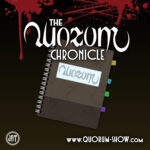This article excerpt, part of a series entitled The Quorum Chronicle, appears in full — along with expanded audio content — exclusively for our Patreon backers. See our Patreon page for further details.
 The film influences that went into crafting the Los Angeles of “All That Glitters” are too numerous to mention. (Or at least too numerous to iterate in a single Chronicle entry.) After all, many of the signature characteristics of the city — at least within the crime genre — are common to nearly the entirety of the noir ouvre. Not that The Gambler’s Tale fits definitively in the noir model: I like to think the world we portray isn’t quite as irredeemable as is the case in true noir, which is why I tend to refer to our story as a hardboiled crime drama — a subtle distinction, but distinct nonetheless. I’ve always thought of it as a sort of hybrid with roots in film noir or hardboiled crime fiction in general. With that in mind, it’s only right to at least attempt to highlight a few memorable standouts.
The film influences that went into crafting the Los Angeles of “All That Glitters” are too numerous to mention. (Or at least too numerous to iterate in a single Chronicle entry.) After all, many of the signature characteristics of the city — at least within the crime genre — are common to nearly the entirety of the noir ouvre. Not that The Gambler’s Tale fits definitively in the noir model: I like to think the world we portray isn’t quite as irredeemable as is the case in true noir, which is why I tend to refer to our story as a hardboiled crime drama — a subtle distinction, but distinct nonetheless. I’ve always thought of it as a sort of hybrid with roots in film noir or hardboiled crime fiction in general. With that in mind, it’s only right to at least attempt to highlight a few memorable standouts.
[What] makes Los Angeles unique as a setting is that the omnipresent sunshine and wide-open spaces serve to make the dark alleys and backroom dealings all the more jarring.
Two of Billy Wilder’s classics immediately come to mind. First, 1944’s Double Indemnity, which presents L.A. as a place where otherwise appealing people are willing to do terrible things, executing an intricate, cold-blooded fraud and murder scheme in the service of all-consuming ambition. Second, 1950’s Sunset Blvd. throws into sharp relief the ultimate futility of ignoring reality in favor of a preferred fantasy, as well as the dissonance between the utter corruption and moral bankruptcy of Hollywood and its irresistible appeal. And both of them highlight the sharp divide between the way things work for the rich and powerful and the less well-connected among us.
That same divide comes through in Howard Hawks’s 1946 classic The Big Sleep, which also deserves credit for explicitly portraying an illicit gambling operation — The Cypress Club — that villain Eddie Mars operates without the slightest fear of legal complications. Of course, we can only hope to recapture a fraction of the chemistry between Humphrey Bogart and Lauren Bacall in that film — though I do think we manage to resolve our mysteries a bit more cleanly. The Big Sleep also features a memorable scene where the protagonist, Philip Marlowe, attempts to decode a mysterious cipher, a task Jimmy also tackles in “All That Glitters” (and which may be of particular interest to anyone who listens all the way through Quorum’s end credits).
Be sure to check out the complete article, in both text and enhanced audio formats, along with the rest of The Quorum Chronicle series, at our Patreon page. And thanks so much for your continuing support of Jabberwocky Audio Theater!
— William R. Coughlan, writer/director of Quorum
